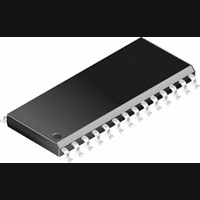CS8420-CS Cirrus Logic Inc, CS8420-CS Datasheet - Page 19

CS8420-CS
Manufacturer Part Number
CS8420-CS
Description
Transceiver IC
Manufacturer
Cirrus Logic Inc
Datasheet
1.CS8420-CS.pdf
(80 pages)
Specifications of CS8420-CS
Audio Control Type
Sample Rate Converter
Supply Voltage Range
4.75V To 5.25V
Operating Temperature Range
-10°C To +70°C
Audio Ic Case Style
SOIC
No. Of Pins
28
Msl
MSL 2 - 1 Year
Frequency Max
108GHz
Bandwidth
20kHz
Rohs Compliant
No
Lead Free Status / RoHS Status
Contains lead / RoHS non-compliant
Available stocks
Company
Part Number
Manufacturer
Quantity
Price
Company:
Part Number:
CS8420-CS
Manufacturer:
CRY
Quantity:
5 510
Company:
Part Number:
CS8420-CS
Manufacturer:
CIRRUS
Quantity:
225
Part Number:
CS8420-CS
Manufacturer:
CRYSTAL
Quantity:
20 000
Company:
Part Number:
CS8420-CS*
Manufacturer:
NEC
Quantity:
700
Company:
Part Number:
CS8420-CSZ
Manufacturer:
CIRRUS
Quantity:
319
Company:
Part Number:
CS8420-CSZ
Manufacturer:
CIRRUS
Quantity:
9 908
Part Number:
CS8420-CSZ
Manufacturer:
CIRRUS
Quantity:
20 000
7.
The CS8420 includes an AES3 type digital audio
receiver and an AES3 type digital audio transmit-
ter. A comprehensive buffering scheme provides
read/write access to the channel status and user da-
ta. This buffering scheme is described in the Ap-
pendix: Channel Status and User Data Buffer
Management on page 72.
7.1
The AES3 receiver accepts and decodes audio and
digital data according to the AES3, IEC60958
(S/PDIF), and EIAJ CP-1201 interface standards.
The receiver consists of a differential input stage,
accessed via pins RXP and RXN, a PLL based
clock recovery circuit, and a decoder which sepa-
rates the audio data from the channel status and
user data.
External components are used to terminate and iso-
late the incoming data cables from the CS8420.
These components are detailed in the Appendix
“External AES/SPDIF/IEC60958 Transmitter and
Receiver Components” on page 70.
DS245PP2
AES3 TRANSMITTER AND
RECEIVER
AES3 Receiver
7.1.1
An on-chip Phase Locked Loop (PLL) is used to re-
cover the clock from the incoming data stream. Al-
though the on-chip sample rate converter is
immune to large amounts of jitter, there are some
applications where low jitter in the recovered
clock, presented on the RMCK pin, is important.
For this reason, the PLL has been designed to have
good jitter attenuation characteristics, shown in
Figures 18, 19 & 20. In addition, the PLL has been
designed to only use the preambles of the AES3
stream to provide lock update information to the
PLL. This results in the PLL being immune to data
dependent jitter affects, since the AES3 preambles
do not vary with the data. The PLL has the ability
to lock onto a wide range of input sample rates,
with no external component changes. If the sample
rate of the input subsequently changes, for example
in a varispeed application, then the PLL will only
track up to ±12.5% from the nominal center sample
rate. The nominal center sample rate is the sample
rate that the PLL first locks onto upon application
of an AES3 data stream, or after enabling the
CS8420 clocks by setting the RUN control bit. If
the 12.5% sample rate limit is exceeded, the PLL
will return to its wide lock range mode, and re-ac-
quire a new nominal center sample rate.
PLL, Jitter Attenuation, and
Varispeed
CS8420
19



















